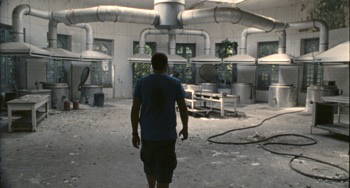L'Intervallo: Taking a Break from Life
Before Sundance and before SXSW, there was New Directors/New Films, Film Society of Lincoln Center and Museum of Modern Art’s annual showcase of work by emerging filmmakers from around the world.
Each year, for the past 42 years, New Directors/New Films unveils a brand-new lineup of fresh faces on the filmmaking scene. You may recognize some names from past festivals: Pedro Almodovar, Kelly Reichardt, Atom Egoyan, Spike Lee, Richard Linklater, Sally Potter, John Sayles, Steven Spielberg, Wim Wenders, and Wong Kar Wai, for example, were all featured by New Directors/New Films early in their careers.
This year the dates of the festival are March 20-31 and screenings will take place at the Walter Reade Theater at Lincoln Center and at The Roy and Niuta Titus Theater 1 at MoMA. Among the films in the program there is one Italian jewel, L'Intervallo by director Leonardo di Costanzo (Friday, March 29 at 6.15 pm; Sunday, March 31 at 4.00 pm).
Written by the director with Mariangela Barbanente and Maurizio Braucci, an important writer of the new Italian fiction genre and screenwriter of Matteo Garrone's Gomorra, L'Intervallo, winner of the Critics’ Prize at the 2012 Venice Film Festival, is a portrait of two adolescents thrown together under the eye of the Neapolitan Camorra. This story of broken love and ruined poetry slowly captures the viewer with its air of menace and sexual tension.
A young man, Salvatore (played by Alessio Gallo) and woman, Veronica (played by Francesca Riso) are confined in a huge abandoned building, the ex-mental institution Leonardo Bianchi of Naples, in a working-class neighborhood. He is a shy ice-cream vendor, she is a feisty local “object of desire.” One must watch over the other. She is a captive because she allegedly has wronged Bernardino (played by Carmine Paternoster), a local gangster, and he is forced by his gang, who has stolen his cart, to be her jailer. Despite their youth, both act older than their age…Veronica as a mature and uninhibited woman, and Salvatore as a young man who must follow orders to preserve his own well-being.
The two fifteen year olds react differently to the violence that is all around them. Veronica is restless and rebellious; Salvatore is yielding and more accommodating; but who knows if it is out or fear or pragmatism. Both are essentially victims, but they blame each other for their imprisonment. As time goes by however, the hostility between the pair softens, leading to intimacy, punctuated with mutual discoveries and confessions. In this frightening and isolated place, Veronica and Salvatore surprisingly find a way to reignite the dreams and illusions of their lost adolescences. The two share a welcomed break from their harsh adult lives, a moment of escapism, an "Intervallo" (a break) before having to address the cruel reality of a violent criminal gang ultimately deciding Veronica's fate.
Director Leonardo Di Costanzo, who has directed many documentaries which have been presented and have won various prizes in some of the most important international film festivals, brings gripping documentary realism and a poetic eye to this quietly intense drama. “L’Intervallo is my first fictional feature film,” Di Costanzo stated, “up till now I had only made documentaries, but my approach to this project has been with the same curiosity towards reality and the unlimited inspiration it can give, and with the same faith in it's endless narrative possibilities. Therefore, in this movie as in any documentary, I begun by observing and listening.”
Closeness to reality was achieved not only in the way the film was shot, but also by the choice of the two main actors, two non-professional kids from the hood. To find the two protagonists, a coaching laboratory for improv acting was held: it involved a group of teenagers of the “Spanish Quarters” with the help of the Teatro Stabile of Naples. The laboratory, which lasted over three months, was directed by Alessandra Cutolo and Antonio Calone, who have been organizing drama lessons for street children in Naples for many years now.
“When we begun writing, we immediately knew that we would have to leave enough space in the screenplay for the actors to create their own characters and back stories,” Di Costanzo stated, “We thought the script as a sort of canvas for the plot, precise, but open enough for the characters. Even if the film was supposed to be acted in Neapolitan dialect, the screenplay was written in Italian, so that the actors -when preparing for the role- would have to translate it and make it their own. To make this possible, from the beginning I decided the two main actors would have to be amateurs.”
The film was shot without any added lighting, with the exception made for some shots at night, and with a shoulder-mounted camera, to better adapt to the way the actors would interact with the location, the ex-mental institution Leonardo Bianchi of Naples, built in the nineteenth century and abandoned many years ago.
“All this to tell a story about teenagers, where adults are absent, and are considered a menace or harbingers of laws and customs that must be followed,” Di Costanco concluded, “Here in the south, the laws are those of the Camorra, which tempts and threatens, and with which anyone must come to terms, in one form or another, when choosing to live in this city.”
Di Costanzo will be present at both screenings at new Directors/New Films:
Friday, March 29 at 6.15 pm
Sunday, March 31 at 4.00 pm






































i-Italy
Facebook
Google+
This work may not be reproduced, in whole or in part, without prior written permission.
Questo lavoro non può essere riprodotto, in tutto o in parte, senza permesso scritto.